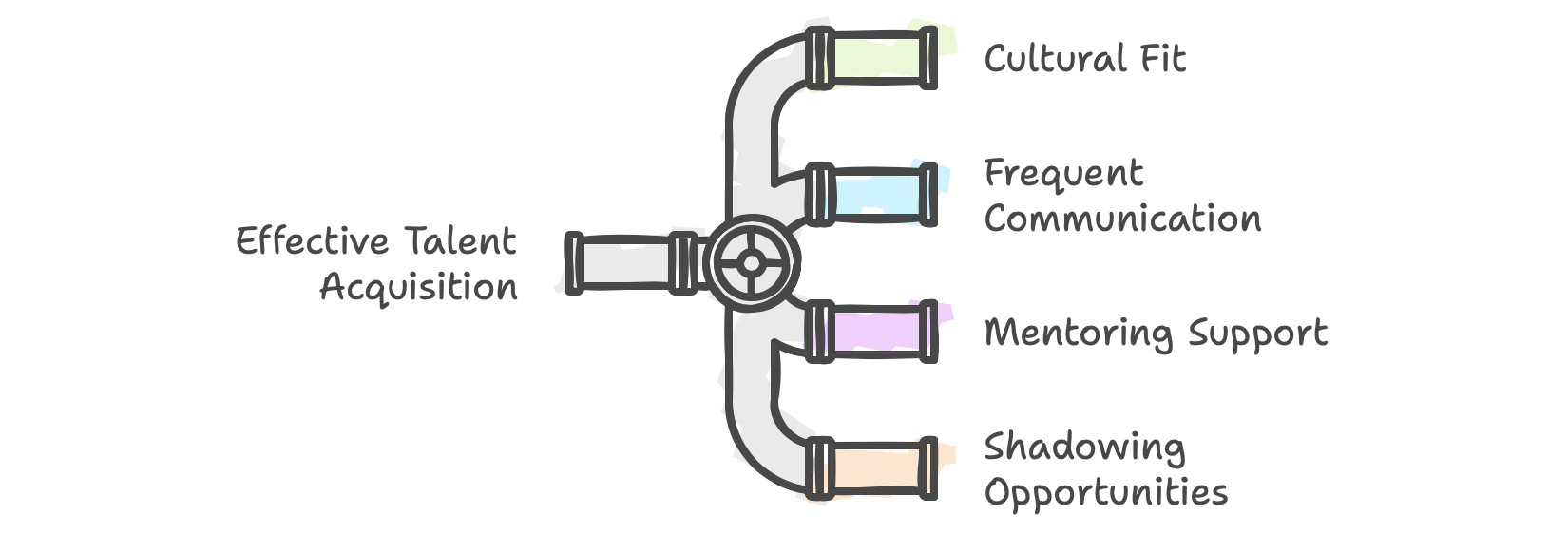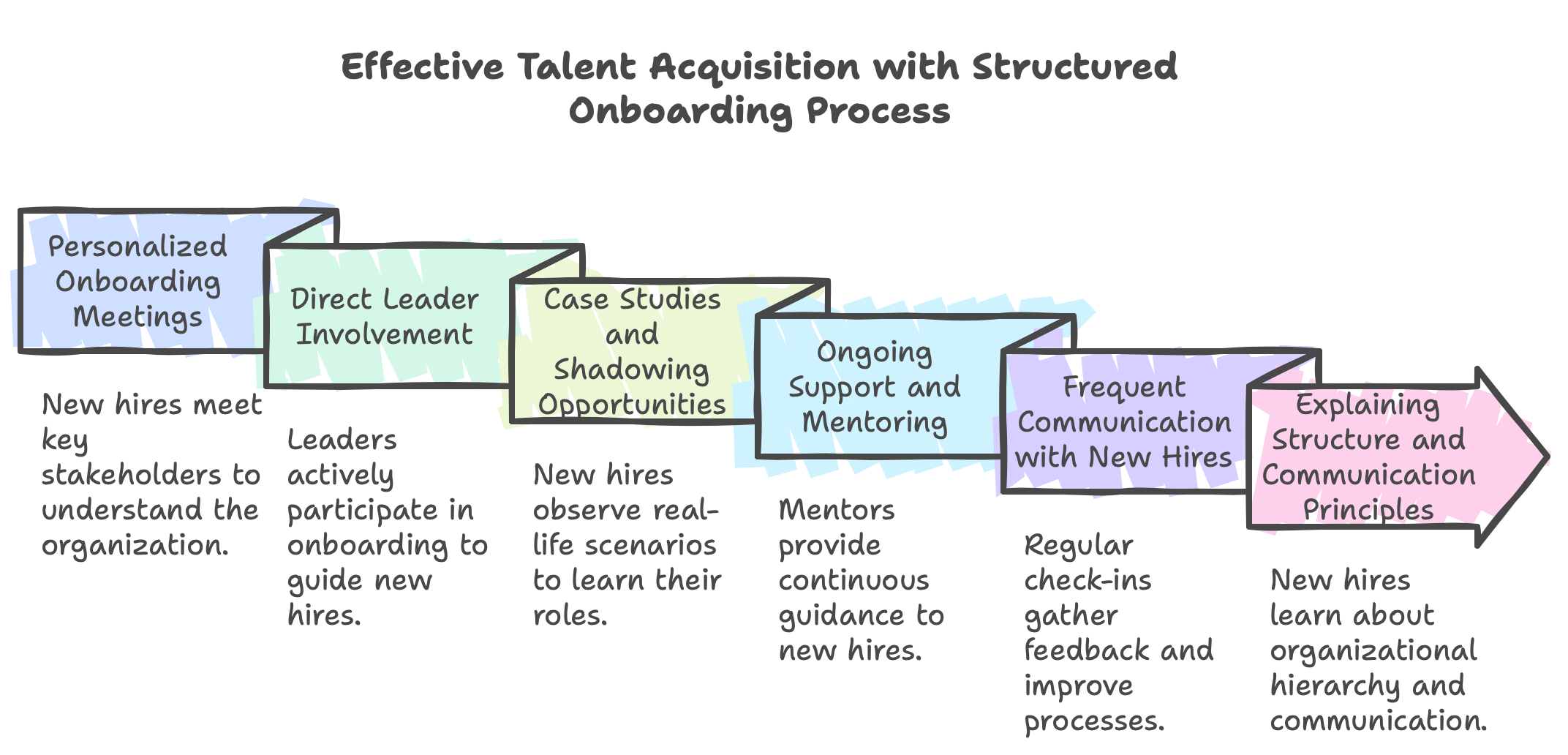Key Insights from 20 years in Talent Acquisition
Through out my 20+ years experience working as a Consultant, Recruiter and Head of People, after successfully placing 1000 candidates into various technology companies, Throughout this journey, I have gained valuable insights into the hiring process, the importance of cultural fit, and the significance of effective onboarding and communication. I recommend you to also read the article: How to Attract, Hire, and Retain Top Talent: Clear Steps for Long-Term Success

I will share my learnings, focusing on essential elements such as onboarding meetings, direct leader involvement, case studies and shadowing opportunities, ongoing support and mentoring, frequent communication with new hires, introducing buddies for guided support, and explaining the structure and communication principles.
You also can read the first part related to the candidates experience and what questions must be asked to unveil a real detail about the business, work atmosphere, your manager background and leading style.
Effective Onboarding Strategies for Long-Term Success
So, let’s begin. I learnt that it would make a lot of sense to implement the following practices and approaches such as:
Personalized Onboarding Meetings
In my experience, the most successful hires receive onboarding process which goes far beyond simply sharing documents with new employees. It includes personal and group onboarding meetings during the first days.
This personalized approach allows new hires to interact with key stakeholders, including team members, department heads, and executives. These meetings provide an opportunity to learn about the organization's structure, culture, and strategic goals, fostering a sense of belonging and connection right from the start.
This personalized approach allows new hires to interact with key stakeholders, including team members, department heads, and executives. These meetings provide an opportunity to learn about the organization's structure, culture, and strategic goals, fostering a sense of belonging and connection right from the start.
Direct Leader Involvement
I support leaders in learning a crucial aspect of the onboarding process – their direct involvement.
As a matter of fact, all leaders are busy, but your new team members most likely will struggle or stay passive without their leader active participation in the onboarding process, by explaining the role, his / her expectations, demonstrating how they lead their team, explaining team dynamics, and sharing insights into the work processes and approaches.
This involvement helps new hires understand the expectations, navigate their roles more effectively, and align their work with team and organizational goals. It also establishes a direct line of communication and support from the leader, promoting a sense of trust and guidance.
As a matter of fact, all leaders are busy, but your new team members most likely will struggle or stay passive without their leader active participation in the onboarding process, by explaining the role, his / her expectations, demonstrating how they lead their team, explaining team dynamics, and sharing insights into the work processes and approaches.
This involvement helps new hires understand the expectations, navigate their roles more effectively, and align their work with team and organizational goals. It also establishes a direct line of communication and support from the leader, promoting a sense of trust and guidance.
Case Studies and Shadowing Opportunities
I wouldn’t recommend just let your new hires work and learn through working. My recommendation is to building a foundation first by providing new hires with a practical understanding of their roles and responsibilities, onboarding should include case studies and shadowing opportunities.
This allows employees to observe real-life scenarios, learn about the decision-making process, and understand how their work contributes to the overall success of the team and organization.
By experiencing hands-on learning and witnessing the application of skills and knowledge, new employees can quickly acclimate to their roles and feel confident in their contributions.
This allows employees to observe real-life scenarios, learn about the decision-making process, and understand how their work contributes to the overall success of the team and organization.
By experiencing hands-on learning and witnessing the application of skills and knowledge, new employees can quickly acclimate to their roles and feel confident in their contributions.

Ongoing Support and Mentoring
One more thing you would want to implement. An effective onboarding process extends beyond the first few days or weeks. It should include ongoing support and mentoring to ensure new hires receive guidance and assistance as they navigate their roles and responsibilities.
Assigning a mentor or buddy within the team can provide a dedicated resource for new employees to ask questions, seek advice, and gain insights into the company's culture and norms.
Ongoing support helps new hires overcome challenges, fosters their professional growth, and enhances their sense of belonging within the organization. You might be interested to read: Our Top Key Insights on Building Successful Teams
Assigning a mentor or buddy within the team can provide a dedicated resource for new employees to ask questions, seek advice, and gain insights into the company's culture and norms.
Ongoing support helps new hires overcome challenges, fosters their professional growth, and enhances their sense of belonging within the organization. You might be interested to read: Our Top Key Insights on Building Successful Teams
Frequent communication with New Hires
In my Talent Team, we go beyond asking closed questions about how new hires are settling into the company.
Our aim is to uncover any areas that may not be working and take actions to create better, more human-centric processes. My personal experience has shown that frequent and open communication between Talent People and New Hires significantly contributes to their success within the business.
Regular check-ins, follow-up meetings, and no formal surveys with new hires after the initial onboarding phase provide valuable insights into their experiences. These interactions allow us to gather feedback on the onboarding process, identify pain points, and make necessary adjustments.
By actively listening to new employees and addressing their concerns, organizations can ensure a seamless transition for future hires and continually improve the onboarding journey.
Our aim is to uncover any areas that may not be working and take actions to create better, more human-centric processes. My personal experience has shown that frequent and open communication between Talent People and New Hires significantly contributes to their success within the business.
Regular check-ins, follow-up meetings, and no formal surveys with new hires after the initial onboarding phase provide valuable insights into their experiences. These interactions allow us to gather feedback on the onboarding process, identify pain points, and make necessary adjustments.
By actively listening to new employees and addressing their concerns, organizations can ensure a seamless transition for future hires and continually improve the onboarding journey.
Explaining Structure and Communication Principles
In businesses with hierarchical structures that cannot be immediately changed, it becomes crucial to explain the underlying reasoning behind the existing information flow and principles of communicating with leadership.
This transparency helps new employees understand the decision-making processes, reporting lines, and expectations within the organization. By providing a clear rationale for the hierarchy, such as efficiency, streamlined decision-making, or specialized expertise, organizations can help new hires appreciate the benefits and navigate the structure more effectively.
This transparency helps new employees understand the decision-making processes, reporting lines, and expectations within the organization. By providing a clear rationale for the hierarchy, such as efficiency, streamlined decision-making, or specialized expertise, organizations can help new hires appreciate the benefits and navigate the structure more effectively.
Key Practices for Long-Term Hiring Success
In my practice, building an authentic employer brand, implementing seamless onboarding, establishing effective communication channels, and explaining the principles of hierarchical structures are vital for long-term hiring success in modern technology companies.
By introducing buddies or guides, organizations can offer dedicated support to new hires, while transparently explaining the reasons behind hierarchical structures helps employees navigate the organization's dynamics more effectively.
I recommend you to read:
Why Startups Need Fractional HR: Immediate Expertise at a Fraction of the Cost
Why we have the brightest minds and still have a highly dysfunctional team?
How Headhunting Differentiates Your Talent Strategy from Regular Recruitment Process?
Why hiring right people can't work without clear and explained culture
By introducing buddies or guides, organizations can offer dedicated support to new hires, while transparently explaining the reasons behind hierarchical structures helps employees navigate the organization's dynamics more effectively.
I recommend you to read:
Why Startups Need Fractional HR: Immediate Expertise at a Fraction of the Cost
Why we have the brightest minds and still have a highly dysfunctional team?
How Headhunting Differentiates Your Talent Strategy from Regular Recruitment Process?
Why hiring right people can't work without clear and explained culture
UnitiQ: Elevating Employer Branding and Onboarding for Long-Term Success
At UnitiQ, we help businesses create strong employer brands and implement smooth onboarding processes that give new hires the best start possible.
Our HR services are designed to enhance communication, improve talent acquisition, and ensure new employees have a clear understanding of their roles and the company structure from day one.
By personalizing onboarding, offering mentorship programs, and explaining how the organization operates, we help companies attract top talent and keep them engaged for the long term.
With UnitiQ, your team will feel supported, connected, and ready to contribute to the company’s success from the very beginning.
We are happy to help you with Talent Acquisition and HR tasks, please contact me, Olga Fedoseeva, Fonder at UnitiQ, directly:
My Telegram
My LinkedIn
Our HR services are designed to enhance communication, improve talent acquisition, and ensure new employees have a clear understanding of their roles and the company structure from day one.
By personalizing onboarding, offering mentorship programs, and explaining how the organization operates, we help companies attract top talent and keep them engaged for the long term.
With UnitiQ, your team will feel supported, connected, and ready to contribute to the company’s success from the very beginning.
We are happy to help you with Talent Acquisition and HR tasks, please contact me, Olga Fedoseeva, Fonder at UnitiQ, directly:
My Telegram
My LinkedIn
